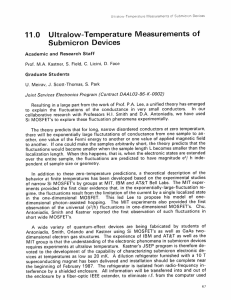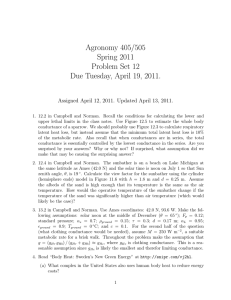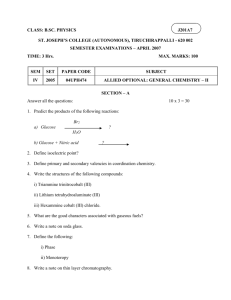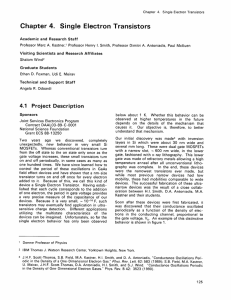Chapter 4. Ultralow Temperature Studies of
advertisement
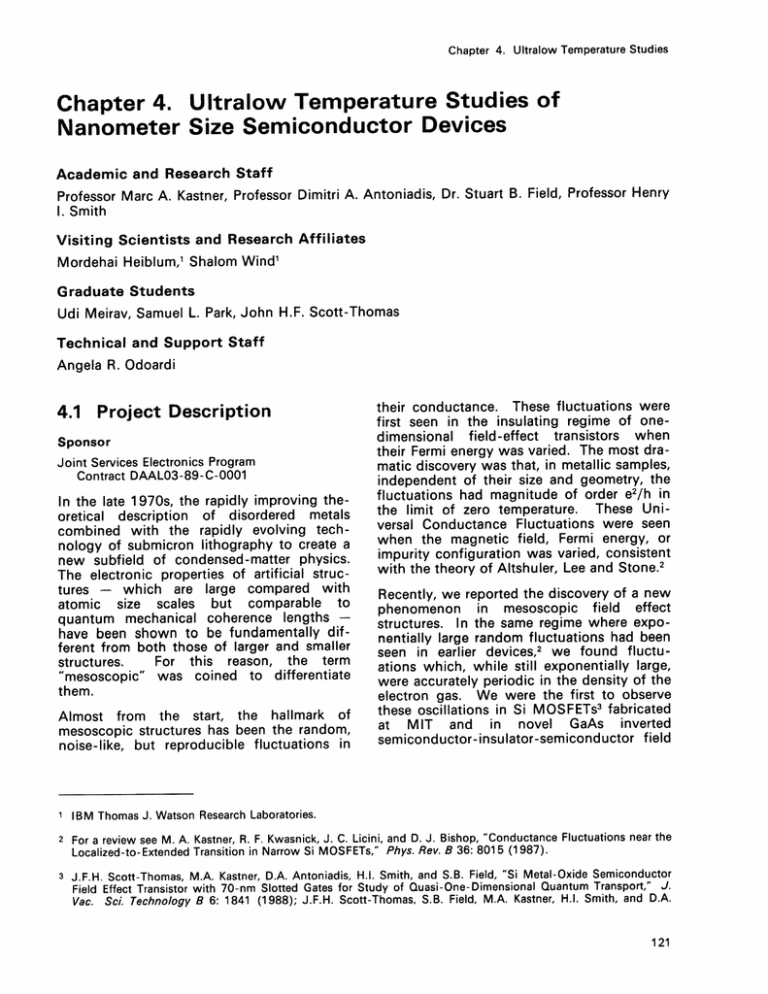
Chapter 4. Ultralow Temperature Studies Chapter 4. Ultralow Temperature Studies of Nanometer Size Semiconductor Devices Academic and Research Staff Professor Marc A. Kastner, Professor Dimitri A. Antoniadis, Dr. Stuart B. Field, Professor Henry I. Smith Visiting Scientists and Research Affiliates Mordehai Heiblum,' Shalom Wind' Graduate Students Udi Meirav, Samuel L. Park, John H.F. Scott-Thomas Technical and Support Staff Angela R. Odoardi 4.1 Project Description Sponsor Joint Services Electronics Program Contract DAAL03-89-C-0001 In the late 1970s, the rapidly improving theoretical description of disordered metals combined with the rapidly evolving technology of submicron lithography to create a new subfield of condensed-matter physics. The electronic properties of artificial structures - which are large compared with atomic size scales but comparable to quantum mechanical coherence lengths have been shown to be fundamentally different from both those of larger and smaller For this reason, the term structures. "mesoscopic" was coined to differentiate them. Almost from the start, the hallmark of mesoscopic structures has been the random, noise-like, but reproducible fluctuations in their conductance. These fluctuations were first seen in the insulating regime of onedimensional field-effect transistors when their Fermi energy was varied. The most dramatic discovery was that, in metallic samples, independent of their size and geometry, the fluctuations had magnitude of order e2/h in the limit of zero temperature. These Universal Conductance Fluctuations were seen when the magnetic field, Fermi energy, or impurity configuration was varied, consistent with the theory of Altshuler, Lee and Stone.2 Recently, we reported the discovery of a new phenomenon in mesoscopic field effect structures. In the same regime where exponentially large random fluctuations had been seen in earlier devices,2 we found fluctuations which, while still exponentially large, were accurately periodic in the density of the electron gas. We were the first to observe these oscillations in Si MOSFETs 3 fabricated at MIT and in novel GaAs inverted semiconductor-insulator-semiconductor field 1 IBM Thomas J. Watson Research Laboratories. 2 For a review see M. A. Kastner, R. F. Kwasnick, J. C. Licini, and D. J. Bishop, "Conductance Fluctuations near the Localized-to-Extended Transition in Narrow Si MOSFETs," Phys. Rev. B 36: 8015 (1987). 3 J.F.H. Scott-Thomas, M.A. Kastner, D.A. Antoniadis, H.I. Smith, and S.B. Field, "Si Metal-Oxide Semiconductor Field Effect Transistor with 70-nm Slotted Gates for Study of Quasi-One-Dimensional Quantum Transport," J. Vac. Sci. Technology B 6: 1841 (1988); J.F.H. Scott-Thomas, S.B. Field, M.A. Kastner, H.I. Smith, and D.A. 121 Chapter 4. Ultralow Temperature Studies effect transistors ISIS structures fabricated at IBM. 4 An example of the latter is shown in figure 1. A rich phenomenology is associated with this oscillatory behavior. The conductance is thermally activated between 1 K and about 0.3 K, and the activation energy oscillates with the number of electrons per unit length. At a lower temperature there is a tunneling component which also oscillates. The conductance is highly non-ohmic, showing dramatic threshold behavior with threshold voltage that oscillates out of phase with the conductance. Most surprising of all, the oscillations are independent of magnetic field. This is probably why the phenomenon was not observed earlier by other groups that typically study MODFETs in which the carrier density can not be varied over a wide range. For the quantum Hall effect, the variation of carrier density is equivalent to the variation of magnetic field. This is not the case for our new phenomenon. The phenomenology suggests that the oscillations result from the opening of an energy gap whenever an integral number of electrons resides in a subsection of the onedimensional channel. Several models have been proposed to explain the observations. It is probable that the electron-electron interactions are crucial. If so, this will be the first time that many-body effects will have been shown to dominate the behavior of mesoscopic systems. The silicon device fabrication and part of the GaAs fabrication was sponsored by the National Science Foundation under Grant ECS 88-13250. A portion of the ultralow temperature measurements was sponsored by the Joint Services Electronics Program under Contract DAAL03-89-C-0001. 2.0 1.5 x010 0.5 (a) 0 535 545 Vg (mV) 555 565 a (b) o 0 200 400 600 800 1000 Frequency 1/v 9 (V 1) Figure 1. (a) Conductance vs. gate voltage of a narrow channel, 2 pm long, measured at T = 50 mK. The inset shows an expansion of the first few oscillations. (b) Fourier power spectrum of the above. The peak corresponds to a period of AVa1.7 mV. Antoniadis, "Conductance Oscillations Periodic in the Density of a One-Dimensional Electron Gas," Phys. Rev. Lett. 62: 583 (1989). 4 U. Meirav, M.A. Kastner, M. Heiblum, and S.J. Wind, "A One-Dimensional Electron Gas in GaAs: Periodic Conductance-Oscillations as a Function of Density," Phys. Rev. (Rapid Comm.) B 40: 5871 (1989); U. Meirav, M. Heiblum, and F. Stern, Appl. Phys. Lett. 52: 1268 (1988). 122 RLE Progress Report Number 132
